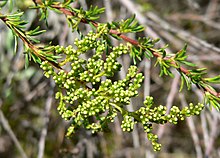Timema cristinae
This species is named in recognition of the person who first found and collected it, Cristina Sandoval.
[3] T. cristinae is among the smallest species of stick insects, with adults only reaching 2-3cm in length.
[2] It is exclusively found in a small region of mountainous habitat (~30km2) covered by chaparral - a specific type of shrubland plant community.
[2] In particular, it is most abundant on two species of shrub: Adenostoma fasciculatum (Rosaceae) and Ceanothus spinosus (Rhamnaceae).
[7] Often eggs are simply dropped from the host-plants, although occasionally individuals will use their abdomens to insert them into the soil.
[7] Most eggs are laid in April and May, and go through a process of dormancy - termed diapause - where they delay development; this lasts for approximately 8 months until hatching begins in December.
[7] Occasionally, some eggs will remain their dormant state for an additional year, waiting to hatch until the following December–January.
[9] He then engages in courtship behaviours which involves leg and antenna waving, before attempting copulation.
[7] The juveniles and adults of T. cristinae remain motionless on their plants during the day, choosing to feed and walk only at night.
[8] Due to its morphs, T. cristinae is used as an eco-evolutionary model to study the ongoing process of evolution.
[2][3][4][5][11][12] Much of this research has focused on the green and striped morphs, as they provide camouflage for two different host-plant species: C. spinosus and A. fasciculatum respectively.
[2][12] This interest has even led to studies examining the genes which decide which morph an individual will display (what colour and pattern they will have).

